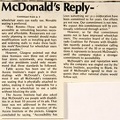The Handicapped Coloradan, October 1984
[Headline] McDonald’s Statement Called “Unacceptable”
The response by McDonald’s to demands by wheelchair protestors that the fast food chain improve the accessibility of its restaurants was described as unacceptable by a spokesperson for the Access Institute.
Wade Blank said that Access was contacting McDonald’s again and if the company’s response did not improve his organization might well return to the picket lines. Starting in June, Access picketed McDonald’s restaurants in Denver, Colorado Springs, Cheyenne, Wyo., El Paso, Tex., Syracuse, N.Y., and Kansas City, Mo.
Demonstrators were arrested in Colorado Springs and at one of the Denver demonstrations. At an Aug. 17 meeting, McDonald’s representatives warned Access that if the protests continued, the fast food chain was prepared to take demonstrators to court.
At that meeting, McDonald’s suggested that it would be willing to remodel restaurants owned by the company, but that it did not have the power to order individually owned franchises to follow suit. Company representatives estimated that the retrofitting operation would affect some 2,200 of the more that 7,700 McDonald’s across the country and would cost between $3 and $5 million.
At a second meeting a week later, McDonald’s seemed ready to make further concessions and promised to issue a policy statement in September. Blank said he had expected that statement to satisfy many of Access’s demands.
Instead, McDonald’s response took the form of a memo from its vice president for national operations to regional managers and vice presidents, outlining the company’s record on accessibility and listing the standards the company suggested its licensees follow.
Blank said the memo shows that McDonald’s is “not really serious about what they’re doing.” In fact, he said, Access did not receive a copy of the memo and had to ask McDonald’s for one.
Throughout the discussions, McDonald’s has argued that it would not bow to pressure and that the company’s record on accessibility was a good one. The memo, dated Sept. 12, 1984 and written by Tom Glasgow, reaffirmed that position.
Glasgow said that since 1979 McDonald’s has been following accessibility guidelines set by the American National Standards Institute (ANSI) for its company-owned (McOpCo) restaurants as well as its licensed operations.
“Currently with in excess of 2000 McDonald’s restaurants accessible to wheelchair users, we are the leaders in this area in the quick service restaurant industry and, indeed most probably, in any segment of the food service industry,” Glasgow wrote.
Glasgow listed four minimum accessibility standards that were followed by McOpCo owned restaurants.
“Parking Spaces-Special parking located as close to the building as possible (striping according to ANSI). In addition, vertical signage making these spaces even more obvious is being installed.
“Ramps/Curb Buts—Convenient as possible to special parking (per ANSI specifications).
“Table Access—Although table heights at McDonald’s restaurants meet or exceed ANSI standards we need tables which wheelchair users can easily use. Movable seating is preferred.
“Rest Rooms- These will be made accessible as remodeling becomes necessary and affordable. Restaurants not currently planning to remodel should make modifications such as installing grab bars and widening stalls to make these facilities more functional for wheelchair users when possible.”
However, Glasgow pointed out that since licenses own three out of every four stores system wide, area managers and vice presidents could only recommend that these standards be followed.
Table access has been one of the Access Institute’s major goals in their dealings with McDonald’s. Currently, most if not all McDonald’s restaurants use seating that is physically attached to tables, making it impossible for a person in a wheelchair to use a table without blocking the aisle.
The Access Institute had also asked that McDonald’s use people with disabilities in at least 10 percent of its ads. That issue was not addressed in the memo.
The memo made no mention of the Access Institute or the pickets. Glasgow concluded by saying, “Accessibility has been something we as a corporation have been committed to for years. Our efforts are not new. Our commitment is not new. We expect this commitment will be continually reinforced through action.”
However, so far that commitment seems not to have impressed wheelchair users. The executive board of the Colorado Coalition for Persons with Disabilities recently passed a resolution calling upon members of the 50 or so organizations it represents to boycott McDonald’s until the company makes a stronger commitment to accessibility.
McDonald’s size and reputation were why the company was singled out by the Access Institute, according to Blank. He said if McDonald’s agreed to their requests then other national chains would follow suit.
- Created on
- Thursday 11 July 2013
- Posted on
- Monday 23 November 2015
- Tags
- Access Institute, access standards, accessible, advertising, ANSI, boycott, CCPD - Colorado Coalition for People with Disabilities, Cheyenne, Colorado Springs, Denver, El Paso, franchise, Kansas City, McDonalds, protesters, Syracuse, Wade Blank
- Albums
- Visits
- 3111
- Rating score
- no rate
- Rate this photo


0 comments